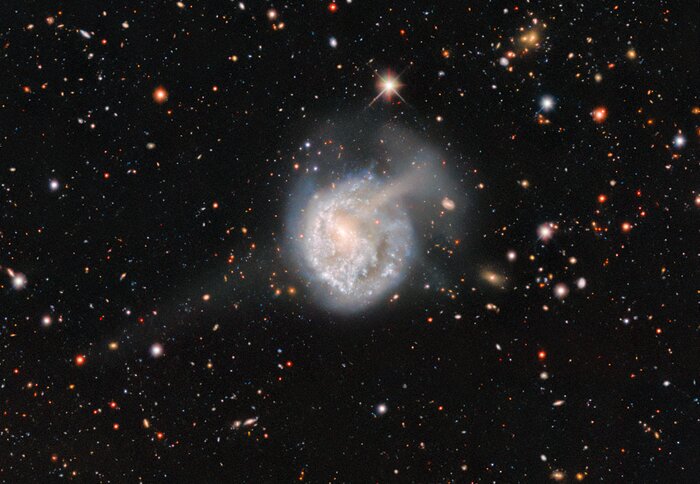The Tidal Tales of NGC 922
In the southern constellation of Fornax lies NGC 922, a peculiar galaxy with a structure that has puzzled astronomers for years. Previously, researchers thought its distinctive features — the stellar plume and off-center galactic bar — resulted from a collision with a nearby dwarf galaxy some 330 million years ago. However, new observations have revealed an umbrella-like tidal tail, seen in this image taken with the DOE-built DECam on the U.S. National Science Foundation Víctor M. Blanco 4-meter Telescope at the Cerro Tololo Inter-American Observatory (CTIO), a Program of NSF NOIRLab. These observations contradict the previous collision theory by showing that this newly detected tail doesn’t align with the trajectory of the dwarf galaxy. Moreover, the dwarf galaxy itself shows signs of ongoing star formation and has a well-defined structure, which is inconsistent with the aftermath of a direct collision. So, a new hypothesis has emerged: that these complex features may be the result of a merger with a ‘stripped’ dwarf galaxy that lost much of its material through past interactions with other galaxies. As scientists rewrite the history of NGC 922, these tidal features make this galaxy a valuable subject for understanding how galaxies evolve after interactions.
Credit:Dark Energy Survey/DOE/FNAL/DECam/CTIO/NOIRLab/NSF/AURA
Image Processing: J. Miller (International Gemini Observatory/NSF NOIRLab), M. Rodriguez (International Gemini Observatory/NSF NOIRLab), T.A. Rector (University of Alaska Anchorage/NSF NOIRLab) & M. Zamani (NSF NOIRLab)
About the Image
| Id: | iotw2439a |
| Type: | Observation |
| Release date: | Sept. 25, 2024, noon |
| Size: | 2290 x 1584 px |
About the Object
| Name: | NGC 922 |
| Distance: | 140 million light years |
| Constellation: | Fornax |
| Category: | Galaxies |
Coordinates
| Position (RA): | 2 25 3.99 |
| Position (Dec): | -24° 47' 25.81" |
Colors & filters
| Band | Wave-length | Tele-scope |
|---|---|---|
| Optical g | 473 nm | Víctor M. Blanco 4-meter Telescope DECam |
| Optical r | 642 nm | Víctor M. Blanco 4-meter Telescope DECam |
| Optical z | 926 nm | Víctor M. Blanco 4-meter Telescope DECam |
